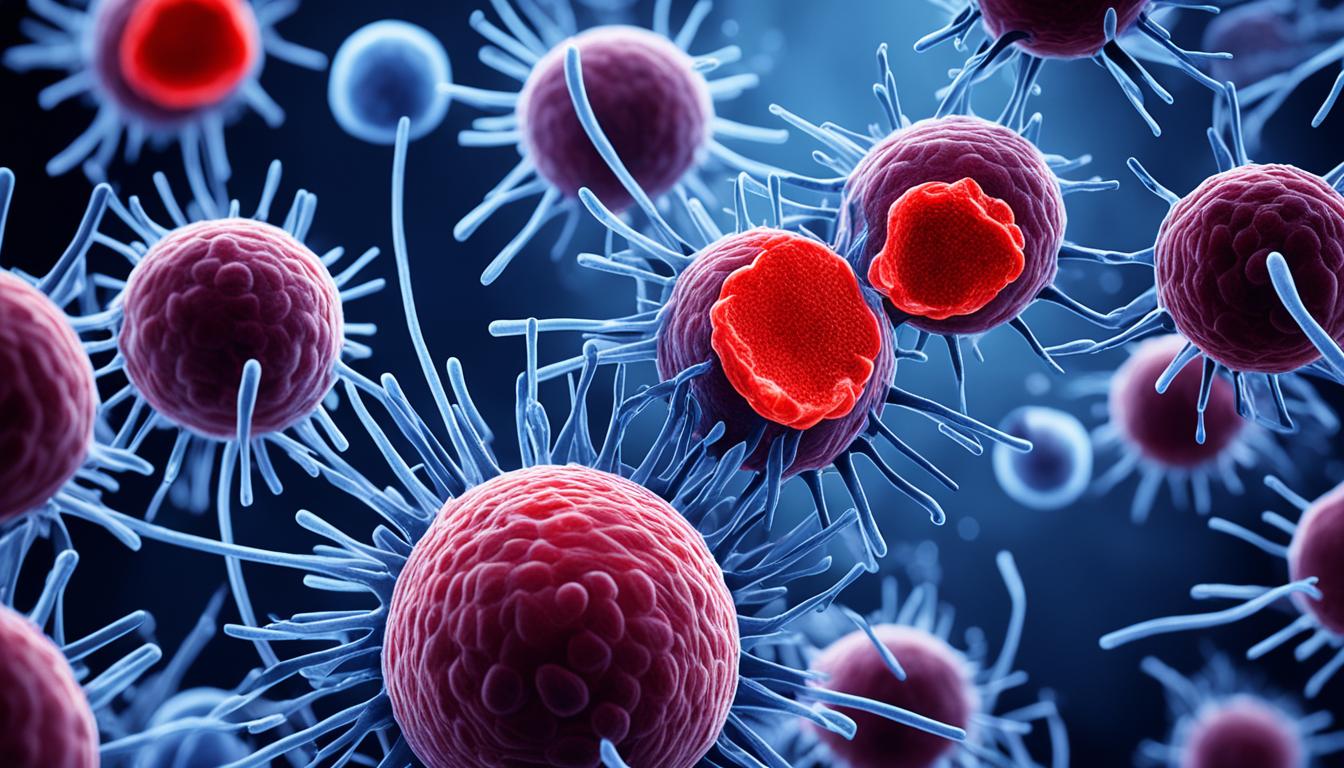Key Takeaways:
- Hairy cell leukemia is a type of cancer that affects the white blood cells, specifically the B cells or B lymphocytes.
- It is characterized by the excessive production of abnormal B cells that have undergone changes and appear “hairy” under a microscope.
- Symptoms of hairy cell leukemia may include fatigue, easy bruising, recurrent infections, weakness, and weight loss.
- The exact cause of hairy cell leukemia is unknown, but it is believed to be related to changes in the DNA of the B cells.
- Treatment usually involves chemotherapy, and in some cases, stem cell therapy may be an option.
Hairy cell leukemia targets our white blood cells, specifically B cells or B lymphocytes. These B cells go through abnormal changes. In a microscope, they look “hairy.” This cancer can cause fatigue, easy bruising, infections, weakness, and weight loss. The cause is not fully clear, but it’s likely due to DNA changes in cells.
Chemotherapy is the common treatment for this leukemia. It lowers the number of abnormal B cells. This helps put the disease into remission. Stem cell therapy, replacing diseased cells with healthy ones, is another treatment choice. It aims to fix the immune system’s functioning. It’s good to know that a fast-progressing form of this disease might need different treatments.
Key Takeaways:
- Hairy cell leukemia is characterized by abnormal B cells that appear “hairy” under a microscope.
- Symptoms of hairy cell leukemia include fatigue, easy bruising, recurrent infections, weakness, and weight loss.
- The exact cause of hairy cell leukemia is unknown, but it is believed to be related to changes in the DNA of the B cells.
- Chemotherapy is the primary treatment for hairy cell leukemia, and stem cell therapy may be an option in certain cases.
- Regular follow-up tests and monitoring are crucial for managing hairy cell leukemia effectively.
Symptoms and Diagnosis of Hairy Cell Leukemia
Hairy cell leukemia is a type of cancer that affects white blood cells. Also known as B cells or B lymphocytes, it shows a variety of symptoms. Sometimes, it’s found by chance in regular blood tests. But when symptoms show up, they can include a full belly feeling, fatigue, and easy bruising. Other common signs are recurring infections, weakness, and losing weight without trying.
It’s important to visit a doctor if these symptoms don’t go away. These signs aren’t just for hairy cell leukemia, but they could mean other things. Still, it’s key to think about this disease as a possible cause.
To diagnose hairy cell leukemia, the doctor will do several tests. They aim to confirm if the disease is present or not. These tests might involve analyzing blood and bone marrow, as well as studying cell markers.
- Complete blood count (CBC): Measures the number of red blood cells, white blood cells, and platelets in the blood.
- Peripheral blood smear: Evaluates the appearance and morphology of blood cells under a microscope.
- Blood chemistry studies: Provides information about organ function and overall health.
- Flow cytometry: Analyzes the characteristics and markers of cells to identify and quantitate abnormal B cells.
- Bone marrow aspiration and biopsy: Involves collecting a sample of bone marrow for examination.
- Immunophenotyping: Identifies specific proteins on the surface of cells for precise classification.
- Cytogenetic analysis: Looks for genetic abnormalities within the cells.
These steps are important in finding and confirming hairy cell leukemia. Each one gives the doctor more details about the disease. They help make a complete assessment of the condition.
Spotting and understanding hairy cell leukemia symptoms early is vital. So is getting the tests needed to be sure of the diagnosis. Seeking medical help right away is crucial. It helps start an effective treatment plan. Next, we’ll look at the treatment options for hairy cell leukemia.
Treatment and Prognosis of Hairy Cell Leukemia
The treatment for hairy cell leukemia varies based on several factors. It looks at the amount of abnormal B and healthy blood cells. Also, it considers if there are symptoms or if organs are involved. Treatment methods include watching without acting, chemotherapy, and surgery. Patients without symptoms might only need to be watched. For those with symptoms, treatment can start right away.
Chemotherapy is common for treating hairy cell leukemia. This treatment uses strong drugs to stop cancer cells from growing. It is not done all at once but in several cycles. Another type of treatment, immunotherapy, uses the body’s natural defense system to attack the cancer. Sometimes, it involves using special antibodies or other immune-strengthening medicines.
Targeted therapy focuses on specific traits of the leukemia cells. It could also target genetic issues. Rarely, surgery to remove the spleen might be needed. This is if the spleen grows too big or gets hurt by the disease. A team of different healthcare workers work together to plan the best treatment for each patient.
Most people with hairy cell leukemia get better and stay that way for a long time. But, the cancer can come back. Also, there are rare cases where the treatments cause effects that show up much later. Checking the health regularly after treatment and keeping a close eye on the leukemia are very important. This helps doctors give the best care and results to their patients.

